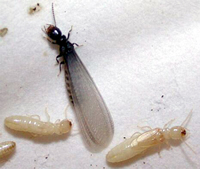
Atlanta eastern subterranean termite Control Service
370,000 homes will need the help of the fire department this year. 2 million will require treatment for termites. Eastern subterranean termites are most likely to attack your home because they are the type of termites most commonly found in the state of Georgia. They are social insects that live in large, underground colonies with at least one queen, but they often have sub-colonies with multiple queens.
Although they could number in the millions, you might never see these termites or any evidence of them–until you discover they’ve done serious damage to your property.
At least one king and queen are at the center of every termite colony. The queen’s sole purpose is to reproduce. Some queens live for as long as 30 years. Queens can lay thousands of eggs every year, and eggs hatch into nymphs.
While in the nymph state, termites diverge into different castes: workers, soldiers, reproductives, and supplementary reproductives. Workers are blind, wingless termites that maintain the colony, build and repair the tubes, forage for food (namely, your house!), and care for the other termites. They are the most numerous caste and the most destructive of the colony, causing 100% of the damage.
Soldiers are sterile, wingless, and blind. Their sole function is to defend the colony. These termites will eventually leave the colony as adult swarmers. After swarming, they shed their wings and pair up. Each male-female pair attempts to start a new colony. This is what the homeowner often sees after the damage has already been done by the worker termites. The winged termites do not damage wood, but they are a definite sign that worker termites are present.
Many people mistake termites for ants, but those “ants” you see at your property might be termites. Learn how to distinguish between ants and termite swarmers with these identifiers:
Those “Ants” could be TERMITES!
Know the difference: Ants vs. Termite Swarmers.
Ants Have:
- Elbowed antennae
- Two pairs of wings, rear wings smaller than from wings
- Wings have few well-defined veins
- Pinched waist
- Long legs
Termites Have:
- Straight antennae
- Two pairs of wings the same size and shape
- More and finer veins in wings that create a lace-like appearance
- Broad waist
- Short legs
